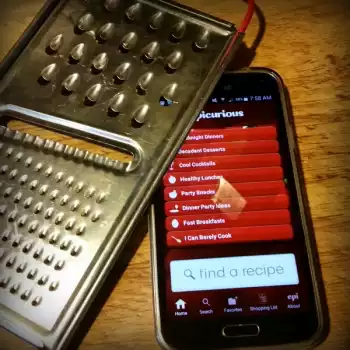
Now, more than ever, I find myself in a love-hate relationship with my smartphone. I love the convenience of reading a magazine, listening to an audiobook, playing a podcast, plugging in my headphones and enjoying music, or reading an ebook from the small electronic device I carry everywhere. At the touch of a fingertip I have available the world at large, together with the smaller universe of my own personal contacts. My camera is always with me. So useful. So many possibilities. So much potential for connected burnout.
My phone is work and personal. Two “owner” accounts housed there move me between business contacts, tasks and communications and my own personal uses, friends, and interests. It used to be a nice place to visit, but I find myself living there too long.
At night, the phone is on my bedside table, where I no longer have a clock, radio, or alarm. If I am unable to sleep there’s a book waiting to light up the display screen. The alarm app sweetly chimes me awake in the morning. Plugging in and recharging the phone’s battery is often my first waking action (after I put my glasses on). Sneak a couple of peeks at alerts and messages to see what happened while I slept? Or get that coffee brewing? So begins another connected day.
The fulcrum swings, balancing screen time with work time, family time, fitness and recreational time, hobby time, creative time, even sleep time. How has the world come to this? I know that I’m not alone in feeling conflicted.
A colleague tells me that his phone is always on radio silence at work, so as to not interrupt meetings, consulting sessions, or his train of thought. “I know I’ll be looking at it every couple of minutes anyway so I’ll see my alerts,” he wryly comments.
When StormTracker6 puts out a weather alert, all over the library you can hear the notification tones buzzing and dinging from phones, both in staff offices and public spaces. Like Pavlov’s weather zombies,we’re conditioned to checking and rechecking the radar on the screen to “track” the storm’s approach.
When my family watches a movie together at home, someone is always tuning into a phone, a computer or a tablet to check messages, or Facebook, Instagram, or whatever grabs their attention. Why do we feel we’re missing out if we’re not keeping up with the stream of content we are “subscribed” to? Multitasking is no longer optional as we juggle connections and conversations online simultaneously with what we’re doing in real life, distracted and overloaded.
I’ve had this particular phone only for a couple of months. Today, I find that it’s loaded and too full to add an app or edit a picture. Mission: forget cleaning the kitchen. Shift priorities and clean up the smartphone. That’s not such a big project. Shouldn’t take too long, right? Almost two hours later, five apps are removed, and 532 photos are transferred to my computer, backed up and cleaned up, giving me space to use the darned thing again. I’m fighting the sensation that this phone is taking over my life.
Back I go to the kitchen to prepare dinner. I’m finding it absorbing and satisfying work as I chop, dice and grate vegetables. My phone blissfully ignored, I carefully juggle several pans and dishes so that food is all done at the same time. Meanwhile, my family members are glued to their individual screens elsewhere in the house. Interrupting them is a challenge, but we’ve mutually agreed that phones are not to be present at meals. The payoff comes big time for me when Daughter compliments my “restaurant quality” vegetarian meal. I didn’t use a recipe app for this meal, just fresh local ingredients and my own creativity and taste, and it feels doubly rewarding.
After dinner, kitchen finally cleaned, it’s time to play ball with the dog. With each toss I am mentally puzzling over how to make photos on my phone save only to my SD card and not to the phone’s limited storage. It bothers me because I can’t figure it out. Distracted? I ask Husband to see what he can do with my phone’s photo storage settings. He spends almost an hour getting nowhere on my phone and his. Now we’re both frustrated. We give up. The dog is bored by now. Nobody wants to look at phones.
So I take out my knitting needles and yarn with plans to do some blessedly low tech knitting while we watch the baseball game on television. To my chagrin, I find the only place I can find my pattern is saved on my tablet, so it’s time to fire up another electronic device. So ends another connected day.
Considering how bound our lives are to technology, with the pains and pleasures it brings, I am reminded of a quote I recently saw making the rounds on Pinterest, thanks no doubt to the popular Grey novels. “Pain and pleasure, like light and darkness, succeed each other.” I was surprised to discover that Laurence Sterne (1713- 1768) wrote this in a sermon when I found it online in “The Works of Laurence Sterne: With a Life of the Author,” a book published in 1823. Even ten years ago, would we have predicted the many facets of enrichment, communication, and community building that our screens and devices offer and how embedded into our daily lives technology has become? My phone can nearly replace any of my computers. No doubt, soon, they will be dusty and neglected, like my old alarm clock radio. Eighteenth century author Sterne has something else to say that seems hopeful and relevant. “The desire of knowledge, like the thirst of riches, increases ever with the acquisition of it.” Here’s to balancing real and virtual connections, knowledge and riches as we live our daily lives.
